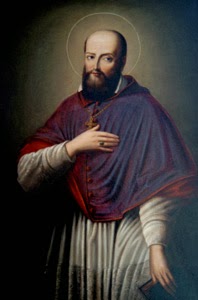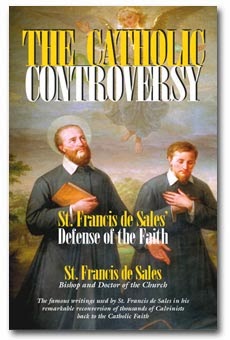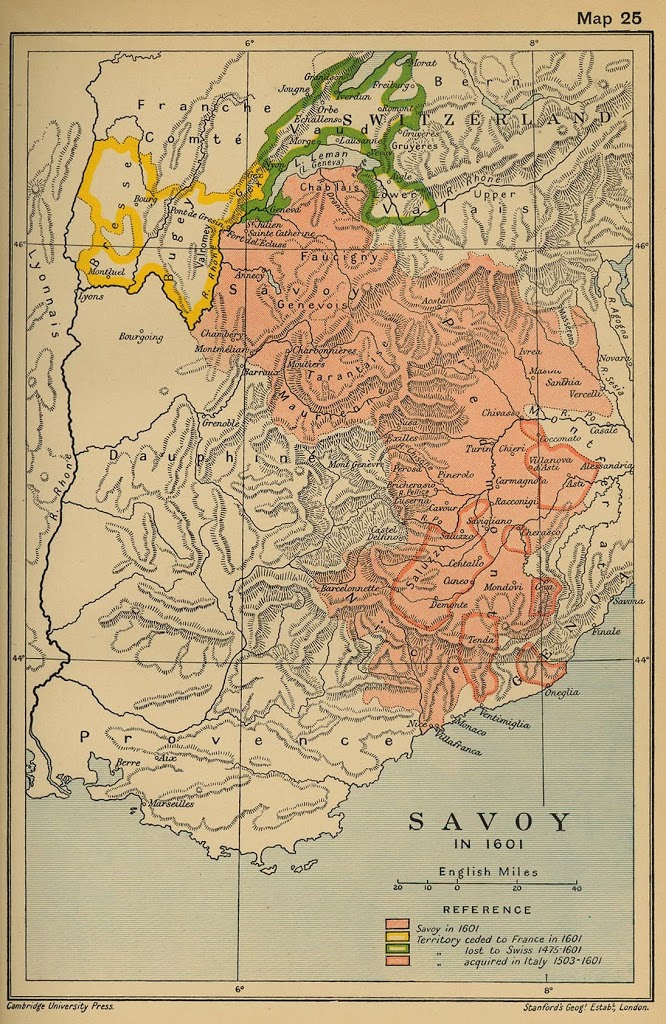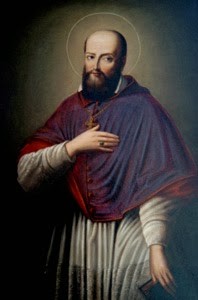St. Francis de Sales (1567-1622) is one of the most well-rounded Saints in Church history, and he played a major role in returning tens of thousands of Calvinists to the Catholic Church. You’ll often find a Saint who was accomplished as a theologian, or as a mystic, or as an apologist, or as a devotional author. Francis was all of these, in addition to being a successful evangelist, and then the bishop of a persecuted Diocese.
 |
| St. Francis de Sales |
His Introduction to the Devout Life was focused on the need for laypeople to be Saints. In this way, as Pope Paul VI noted, he anticipated the emphasis of the Second Vatican Council… about four hundred years ahead of time:
No one of the recent Doctors of the Church more than St. Francis de Sales anticipated the deliberations and decisions of the Second Vatican Council with such a keen and progressive insight. He renders his contribution by the example of his life, by the wealth of his true and sound doctrine, by the fact that he has opened and strengthened the spiritual ways of Christian perfection for all states and conditions in life. We propose that these three things be imitated, embraced, and followed.
But his writings weren’t just devotional. He also was a brilliant apologist. He was a priest, and later bishop, of Geneva, when the city (and much of the surrounding area) was under strict Calvinist control. The people were banned from attending Mass, or even listening to a Catholic preach; Francis got around this by writing apologetics tracts comparing Catholicism and Calvinism, and posting them wherever he could, even sliding them under townspeople’s doors. These tracts, later assembled as the book Catholic Controversy, were massively influential. The Superior of Annecy, Mother de Chaugy, said in 1661: “It is considered that this Treatise is calculated to produce as much fruit amongst heretics for their conversion as the Introduction to a Devout Life amongst Catholics for devotion.”
In addition to his devotional and apologetical writings, he also was a brilliant theologian who helped orchestrate something of a cease-fire in the debates between the Dominicans and Jesuits on grace and predestination. He also wrote the mystical Treatise on the Love of God, of which Pope Benedict XVI said: “In an intensely flourishing season of mysticism The Treatise on the Love of God was a true and proper summa and at the same time a fascinating literary work.”
 |
| Cover of the TAN edition of The Catholic Controversy, showing Francis and Louis praying to the Guardian Angel of the diocese as they embark on their mission. |
Behind all of his devotional, apologetical, theological and mystical contributions was a true evangelist and pastor of souls, and it’s this aspect of St. Francis de Sales that I want to emphasize. From the start, he gave up nearly everything to be a priest. He came from a prominent, well-connected, devoutly Catholic French family. His father, François de Sales, Lord of Boisy, Sales, and Novel, was a magistrate. He wanted Francis, the eldest of his thirteen children, to follow in his footsteps. He sent his son to some of the finest schools in Europe. By age 25, Francis had graduated from the Collège de Clermont (where he studied philosophy and humanities) and had received a doctorate in law and theology from the University of Padua .
Francis was quickly admitted to the Bar, although he held out hopes of becoming a priest instead. At Clermont, a priest had helped him battle depression and despair, and this encounter seems to have planted the seeds for Francis’ own vocation. His father, meanwhile, had secured a variety of prestigious positions for him, including as a senator. A compromise was finally secured, brokered by Francis’ cousin, Canon Louis de Sales: François would agree to let Francis become a priest, in exchange that Francis would be appointed Provost of the cathedral chapter of Geneva, a prominent position within the diocese. Both François and the Bishop of Geneva agreed, and Francis was ordained the next year.
Almost immediately, Francis plunged himself into reconverting the people of his diocese. In 1594, at age 26, Francis and his cousin Louis embarked on a lengthy mission of conversion in and around the Calvinist district of the Chablais, in what was then the northern edge of the Duchy of Savoy (modern-day Switzerland and France). Here’s how he described the situation that he entered into:
When we entered those bailiwicks, sad indeed did everything appear. For we saw sixty-five parishes, in which, except the officials of the Duke, there were not, among so many thousands of persons (ex tot millibus), one hundred Catholics. The Churches, partly stripped, partly in ruins; nowhere the sign of the cross, nowhere altars; and everywhere all vestiges of the ancient and true faith destroyed; everywhere ministers – i.e., teachers of heresy.
 |
| Religious Map of Central Europe, 1618. h/t Emerson Kent Click to enlarge. Geneva (red: Calvinist) and Savoy (blue: Catholic) are in the bottom-left corner. |
A number of priests face challenging assignments after ordination, but this is on a whole other level: Geneva had been subjected to a generation-long campaign to try to purge all vestiges of Catholicism: altars and statuary destroyed, churches whitewashed, and the Catholic religion crushed in every way. In another letter, he added that the people were forbidden, by law, from hearing him preach: “The obstinacy of this people is so great that is has been forbidden by public ordinance to come to Catholic sermons.”
In response to this, as I mentioned, Francis wrote the apologetics tracts that would become The Catholic Controversy. But for the first two years, he met with little success. The people he was trying to convert wouldn’t listen to him, much less give him anything to eat, or a place to sleep. Mackey notes:
It is on authentic record that he could not even buy bread, that on one occasion he and his cousin only saved themselves from being frozen to death by taking refuge for the night in the village bakehouse. On December 12, 1594, benighted in a wood frequented during the deep snow by packs of wolves, he had to tie himself to the higher branches of a tree, and was found by some peasants next morning utterly benumbed and almost dead.
That’s how much he loved his people, even when they turned their backs on him.
All of this, of course, was taxing on him. His father refused to continue funding his mission, because it seemed like a hopeless cause. Eventually, exhausted and out of money, even Louis turned back.Reportedly, there were even assassination attempts made on Francis’ life. In a 1595 letter to Antoine Favre, baron of Pérouges, Francis wrote:
The harvest in Thonon is a burden which depletes my strength, but I am resolved not to abandon it with your agreement (and) your order. However, I continue to prepare by all sorts of expediencies and labors new workers for this work, and to seek them by means of subsistence. I notice no end, no close to the ruses of the enemy of the human genre. I have been tormented and I am still, my Brother, seeing that among such catastrophes that threaten our heads, there remains for us scarcely a moment to cultivate the devotion of which we would have so pressing a need. It is necessary however, counting on the mercy of Our Lord, to elevate our hearts to greater hopes.
Truly, it is a testament to his piety that the biggest struggle he complained of was wanting more time to pray.
 |
| Map of Savoy, 1601. The Chablais is the northernmost section in red, flanked by French (yellow) and Swiss (green) territory. h/t Emerson Kent. Click to enlarge. |
It would have been easy for him to give up, but by the grace of God, he didn’t. His persistence paid off. Over the span of a few years, fruit began to sprout up. Ultimately, the mission was a huge success, with nearly every one of the 72,000 souls living in the Chablais returning to Catholicism. Mackey describes it this way: “At the end of four years the whole country was Catholic, the parishes organized, churches being restored and scarcely one hundred Calvinists remained.”
This legacy continues to the present day, in the form of a continual Catholic presence. For example, the great Church of Saint Hippolytus, built in the 12th century, became Calvinist in 1536. Under the influence of St. Francis de Sales, it returned to the Catholic Church in 1594, and remains Catholic today.
So what contributed to the success of St. Francis’ mission to the Chablais? Certainly, his natural talents play some role, but I would suggest that God made great use of his charity and his persistence.
He combined a solid orthodoxy with an intense pastoral devotion. On doctrine, he wouldn’t move an inch; pastorally, there was nothing he wouldn’t do. In fact, he coined the saying, “A spoonful of honey attracts more flies than a barrelful of vinegar.” He lived out Matthew 18:12 in a radical way, going to extreme (sometimes life-threatening) ends to save even a few souls. He’s the Patron Saint of the Catholic press, because of the way that he used media (at the time, printed tracts and books) to evangelize when all of the other doors were shut, and to provide spiritual direction. He’s also the Patron Saint of the deaf, for an even more radical reason: in order to teach a deaf man about God, St. Francis invented a form of sign language.

These are great stories of S. Francis de Sales, and can teach us some tactics for the New Evangelization. The first lesson is to never give up trying to reach out to any who are confused as to the nature of the true Church. Too many Catholics immediately think it is impossible to make a difference and so they never even try. It should be exactly the opposite. The more who are against the faith, the more laborers are needed to work towards correcting and enlightening them.
What tactics can we use? We can start with the same tactics that St. Francis de Sales used, and also other Saints, such as St. John Bosco…another admirer of Francis de Sales, which is the distribution of good Catholic Literature. In our modern days this can include all forms of media, like holy blogs, good books, EWTN TV and Radio, Youtube talks etc…
We should be spreading all of these to others on a continual basis. Catholic Radio in particular can make a great difference especially to those who commute long distances every day to work. Getting these people to tune in on a daily basis can truly change the world! Every Catholic should have Catholic Radio station cards with them where ever they go. I personally have handed out hundreds per week over the last year and a half. Very easy to do and only the Lord knows whose hands they will fall into. This is something that every Catholic can do. We just need to be like S. Francis de Sales and never give up the holy labor. Maybe it will pay off in the end, like it did for him?